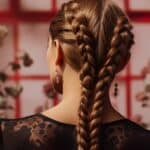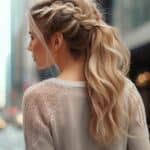Straight hair, characterized by its smooth, flat, and sleek appearance, flows directly from the root to the tip without curls or waves. Its naturally shiny finish often gives it a polished look, resulting from the even distribution of oil from the scalp along the hair shaft. Across cultures and throughout history, straight hair has been celebrated and styled in countless ways, and, like all hair types, it comes with its unique set of care needs and considerations. Explore the intricacies, beauty, and maintenance tips for straight hair.
Type 1 hair, commonly known as straight hair, is characterized by its lack of curl and natural sheen. This hair type is typically divided into three subcategories – 1A, 1B, and 1C – based on the level of straightness and thickness. While 1A hair is entirely straight and fine, 1B has slightly more body, and 1C boasts a coarser texture. Straight hair can seem simple to maintain and style, but it faces its own set of challenges.
Understanding the genetics behind straight hair is crucial for properly caring for and styling it. The straightness of Type 1 hair is determined by the hair follicle’s shape and the distribution of proteins and oils along the hair shaft. These factors contribute to the hair’s natural shine and texture. By recognizing the unique characteristics of straight hair, individuals can better address common problems and enhance their locks’ overall health and appearance.
Caring for straight hair requires a careful balance of cleansing, conditioning, and styling techniques. Frequent washing may be necessary to prevent oil buildup on the scalp, but over-washing can strip the hair of essential moisture. Various styling practices can create volume and texture in straight hair, but excessive use of tools and products can result in damage. To ensure optimal care for Type 1 hair, developing a tailored hair care routine that addresses the specific needs of straight hair is essential.
Key Takeaways
- Type 1 hair, or straight hair, is divided into 1A, 1B, and 1C based on straightness and thickness.
- The genetics of straight hair determine its shine, texture, and unique care requirements.
- Proper cleansing, conditioning, and styling are crucial for maintaining the health and appearance of straight hair.
Understanding Straight Hair
Definition of Straight Hair
Type 1 hair, referred to as straight hair, is characterized by its lack of natural curls or waves. This hair type lies flat on the scalp and typically has a shinier appearance due to the ease with which the hair’s natural oils can travel from the roots to the tips. Straight hair has three subcategories: Type 1A, Type 1B, and Type 1C.
- Type 1A: Very straight and fine hair with no hint of wave or curl
- Type 1B: Straight hair with a slightly thicker texture and minimal body or bounce
- Type 1C: Straight hair with a coarser texture and more body, but still lacking any natural wave or curl
Characteristics of Straight Hair
Straight hair has several distinct characteristics that set it apart from other hair types:
- Natural sheen: Due to the even distribution of the scalp’s oils along the length of the hair, straight hair usually appears shinier than other hair types.
- Lack of curl: Type 1 hair has no natural curl or wave, which means it tends to fall flat against the scalp and may appear limp or lifeless compared to more textured hair types.
- Low porosity: Straight hair typically has low porosity, meaning it is more resistant to absorbing moisture and can take longer to dry. This can also affect how the hair responds to certain styling products or treatments.
- Less prone to frizz: Straight hair is generally less prone to frizz and maintains its shape with minimal effort due to the absence of curls or waves.
Caring for and styling straight hair often involves selecting products and techniques that enhance shine, maintain smoothness, and add volume or body where desired. Individuals with straight hair must understand their specific hair type to unlock its full potential and achieve healthy, vibrant locks.
Genetics of Straight Hair
Straight hair is determined by various genetic factors playing a significant role in a person’s hair type. Different heritages can lead to distinct hair textures, such as straight, wavy, or curly, depending on the combination of traits inherited from each parent. Researchers have analyzed the genomes of thousands of individuals to identify specific gene variations linked to hair types, including straight hair.
In terms of the inheritance of hair type, when a person with straight hair passes on their alleles to a child, the outcome of the child’s hair type will depend on the combination of alleles they receive from both parents. For example, if two straight-haired parents carry the “ss” genetic marker, the child will have straight hair. A wavy-haired parent carrying the “Cs” gene paired with a straight-haired parent (ss) can result in either straight (ss) or wavy hair (Cs) in their offspring, as explained on the CRI Genetics website.
While different genes might be involved in various ethnic backgrounds that influence hair texture and thickness, the overall understanding of how genetic factors contribute to determining straight hair is still in its early stages. The complex interaction between multiple genes makes it challenging for scientists to pinpoint the traits that lead to hair diversity.
In conclusion, genetic factors are crucial in determining a person’s hair type, including straight hair. Research is ongoing to uncover the specific gene variations and how they influence hair texture and thickness in different populations.
Caring for Straight Hair
Type 1 hair, also known as straight hair, has distinct characteristics and requires specific care to maintain its smooth and shiny appearance. This section will discuss appropriate shampooing and conditioning techniques and recommended hair products for straight hair.
Appropriate Shampooing and Conditioning
While straight hair tends to get oily quickly, it’s crucial not to over-wash it, as this can cause more harm than good. Aim to wash your hair only when it starts looking dull or greasy. To ensure proper hair care, follow these steps:
- Wet your hair thoroughly with lukewarm water.
- Apply a small amount of shampoo, focusing on the scalp but avoiding the ends of your hair.
- Massage the shampoo gently into your scalp for about a minute.
- Rinse the shampoo out thoroughly with lukewarm water.
- Squeeze out excess water and apply a conditioner, concentrating on the mid-lengths and ends of your hair.
- Let the conditioner sit for a few minutes before rinsing it with cold water to seal the hair cuticles.
Recommended Hair Products
When selecting hair products for Type 1 hair, choose lightweight and non-greasy options to avoid weighing down your hair. Here are a few products you can consider:
- Leave-in Conditioner: A leave-in conditioner like Daily Dose Miracle Moisture helps moisturize your hair without making it look greasy.
- Volumizing Mousse: A volumizing mousse can provide extra lift, especially if your straight hair is fine and lacks volume.
- Heat Protectant: A heat protectant is essential to prevent heat damage using heat-styling tools such as flat irons or hairdryers.
By following the proper shampooing and conditioning techniques and choosing suitable hair products, you can effectively care for your straight hair, keeping it healthy and beautiful.
Styling Straight Hair
Tips for Styling
When styling straight hair, remember several tips for the best results. First, to achieve a sleek and shiny look, it’s essential to use a quality flat iron and heat protectant spray to prevent damage. Applying a lightweight serum or oil can also help to add shine and reduce frizz.
To maintain the look of your straight hair, washing it less frequently (around 2-3 times a week) is recommended. This helps to preserve the natural oils in your hair that contribute to its overall health and appearance. Dry shampoo can be used between washes to keep your scalp fresh and absorb excess oil.
When styling, opt for a wide-tooth comb instead of a brush to detangle and avoid pulling out or damaging your hair. For added volume, use a root lifting spray, blow dry your hair upside down or use velcro rollers on damp hair to lift your roots.
Common Hairstyles
For those with Type 1 straight hair, various hairstyles can be easily achieved to help showcase your hair’s natural texture. Among these styles are:
- Sleek Straight Ponytail: Pull your hair back into a smooth, tight ponytail with a hair tie and a brush. Use a smoothing serum or pomade to tame flyaways and create a polished look.
- Half-Up, Half-Down: This versatile style is perfect for casual and formal occasions. Gather the top section of your hair and secure it with a hair clip or tie. For added elegance, incorporate a braid or twist.
- Long Layers: Long layers suit straight hair textures well, creating movement and dimension without reducing overall thickness. Visit your hairstylist to get the ideal layered cut for your face shape.
- Side-Swept Bangs: Side-swept bangs can add a soft, flattering frame to your face. They’re easily maintained and can be styled to suit various hairstyles.
Simple Updos: Straight hair can quickly transform into elegant updos such as chignons, French twists, or low buns. Accessorize with decorative hairpins or clips for added sophistication.
When appropriately executed, these styling tips and hairstyles can help accentuate the beauty of straight hair and give you fresh, elegant, and on-trend looks.
Problems Commonly Faced by Straight Hair Types
Straight hair types, specifically Type 1 hair, commonly face specific challenges, including oiliness, lack of volume, difficulty in styling, and increased vulnerability to environmental damage. Understanding these issues can help individuals with straight hair better care for their locks and prevent potential pitfalls.
Type 1 hair, which consists of three subtypes (1A, 1B, and 1C), is prone to oiliness since the hair’s natural oils easily travel from the root to the tip, causing a greasy appearance 1. Regular shampooing and using lightweight hair products can help reduce the oily appearance while maintaining the hair’s natural shine.
Lack of volume is another common problem for those with straight hair face, particularly for Type 1A and Type 1B. Due to the hair’s flat nature, it may appear lifeless and weighed down. Incorporating volumizing shampoos and conditioners and using hair styling techniques such as teasing or a texturizing spray can significantly improve the hair’s body and fullness.
On the other hand, straight hair types can also experience difficulty styling. Since Type 1 hair is naturally resistant to curls, individuals with this hair type may find it challenging to achieve their desired look. Using a curling iron, heat protectant sprays, and long-lasting styling products can help to create and maintain the curls, but some individuals may still find it hard to retain the style.
Lastly, straight hair increases the risk of environmental damage from wind, sun exposure, and pollution. The hair’s smoother texture offers less protection from these external stressors. Therefore, it’s essential to shield the hair from such damage by using UV protectant sprays, avoiding excessive heat styling, and keeping the hair moisturized and well-conditioned.
In conclusion, by identifying these problems and implementing appropriate actions, individuals with straight hair can maintain their hair’s health and achieve the desired look.
Conclusion
In conclusion, Type 1 hair, also known as straight hair, is a common hair type classified into three subcategories: Type 1a, 1b, and 1c. Each subcategory has its characteristics, with Type 1a hair being the finest and most delicate, while 1c hair tends to be thicker and coarser.
Caring for straight hair can be easy for some, but using appropriate products and adopting a healthy hair care routine is crucial. It is vital to note that people with straight hair will style and maintain their hair differently than those with curly hair. Straight hair can quickly become oily due to the lack of curls, so keeping hair clean and well-nourished is essential.
Straight hair maintains its shine and silky texture regardless of weather conditions, making it less prone to frizz than curlier hair types. However, being gentle with straight hair is essential, as finer hair strands can be susceptible to breakage.
In summary, understanding and embracing one’s hair type, especially Type 1 hair, plays a significant role in maintaining healthy, lustrous hair. Proper care, styling techniques, and the right products will ensure straight hair stays beautiful and vibrant.
Frequently Asked Questions
How to care for Type 1B hair?
Type 1B hair is mostly straight but has more body than Type 1A. Establish a regular hair care routine that includes gentle shampooing, deep conditioning, and using the right hair products to care for this hair type. Be sure also to avoid excessive heat and chemicals to prevent damage.
What are the differences between Type 1A, 1B, and 1C hair?
Type 1 hair is generally categorized as straight hair. However, there are differences within this type: Type 1 hair is pin-straight, soft, shiny, and wispy. It does not hold curls well. Type 1B hair is mostly straight but has more body than Type 1A. Type 1C hair is generally straight with somebody and slight bend.
What are the unique characteristics of Type 1 hair in males?
Type 1 hair in males is similar to that in females, with straight, soft, and shiny characteristics. However, male hair may be somewhat thicker and have less tendency for frizz due to the presence of androgens. The amount of body and bend can vary, depending on the specific type (1A, 1B, or 1C).
Best styling techniques for straight hair types?
Consider using lightweight products such as serums, sprays, or mousses for straight hair types to avoid weighing the hair down. Blow-drying with cold air, allowing hair to air-dry partially, and using a straightening serum or leave-in conditioner can help maintain the hair’s sleek appearance. Be sure to avoid overusing heat styling tools, as they can cause damage to your hair.
How to manage Type 1B hair for females?
To manage Type 1B hair for females, incorporate a gentle hair care routine that focuses on maintaining the hair’s health and minimizing damage. This may include using gentle shampoos and conditioners, avoiding harsh chemicals and heat, and utilizing styling products that provide hold without being heavy. Regular trims can also help maintain a healthy appearance and prevent split ends.
Comparing Type 1 and Type 2 hair: What are the key differences?
While Type 1 hair is characterized by its straight texture, Type 2 hair is known for its wavy nature. Type 1 hair includes subcategories 1A, 1B, and 1C, with varying degrees of body and bend. Type 2 hair, on the other hand, has a more distinct S-shaped pattern and includes subcategories like 2A, 2B, and 2C. These subcategories differ in terms of wave definition and frizz. Overall, the critical difference between Type 1 and Type 2 hair is the presence of waves or curls in Type 2 hair, while Type 1 remains straight.






